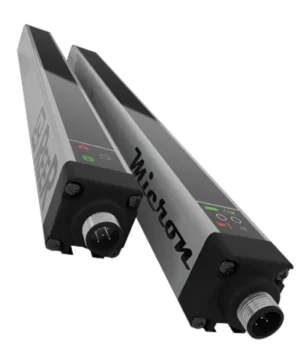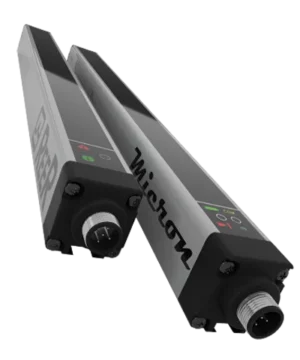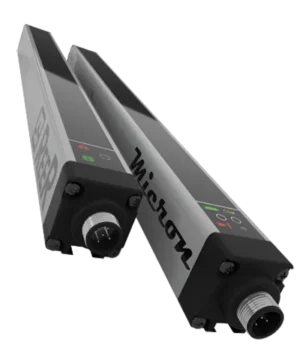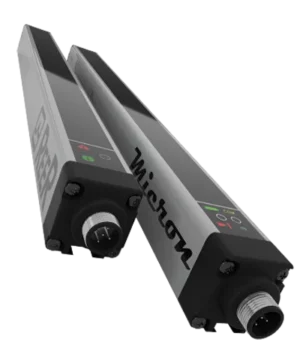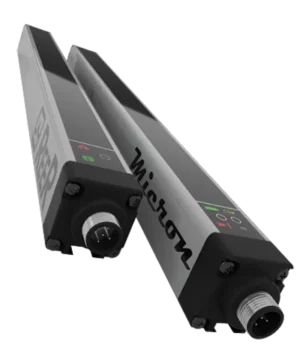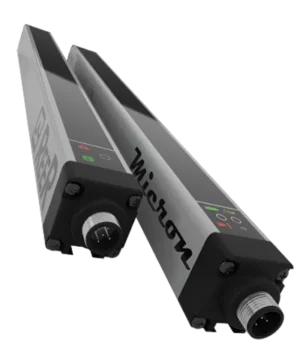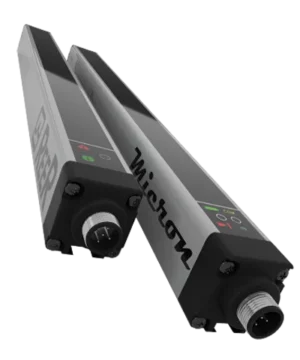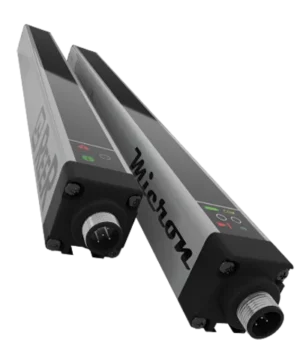MEASUREMENT SENSORS/ MEASUREMENT LIGHT CURTAINS What Are Measurement Light Curtains? Measurement sensors are advanced optical sensors used to perform non-contact measurement tasks in industrial environments.…
MEASUREMENT SENSORS/ MEASUREMENT LIGHT CURTAINS
What Are Measurement Light Curtains?
Measurement sensors are advanced optical sensors used to perform non-contact measurement tasks in industrial environments. Unlike safety light curtains that trigger machine stoppage for personnel protection, measurement sensors are designed for precise scanning of objects. They emit a grid of infrared or laser beams and detect interruptions to calculate dimensions such as height, width, position, and shape.
These light curtain sensors are commonly used in applications like profile detection, quality control, object counting, and edge or gap measurement. Key technologies include fine beam spacing, fast response times, both analog and digital outputs, serial interface support, and wide operating range. With programmable functions and integration into PLCs or industrial control systems, measurement sensors enhance automation accuracy and productivity. They are also used in civil applications requiring precise monitoring and detection of object presence, contributing to both industrial and public sector efficiencies.
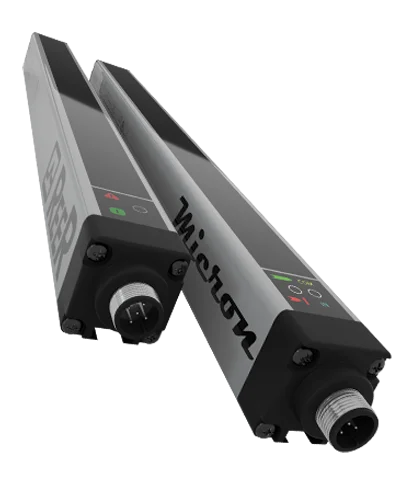
Distinction Between Measurement and Safety Light Curtains
Measurement light curtains and safety light curtains serve different roles in industrial automation. While safety light curtains are designed to prevent access to hazardous zones, measurement light curtains focus on dimensional measurement, profile detection, and non-contact object scanning. They are optimized for high-resolution distance, height, and thickness measurements, making them ideal for quality control and process optimization.
Key Features of Measurement Light Curtains
Advanced Synchronization
Modern measuring light sensors use internal synchronization and signal filtering to minimize cross-talk and improve precision. Advanced synchronization ensures reliable detection of even transparent or small objects. Synchronisation between emitter and receiver units is critical to achieving high-precision, real-time measurements.
Controlled Height Measurements
These devices provide accurate height measurement sensors, often used in packaging lines, sorting stations, or profile checking. Users can configure defined measuring zones to tailor performance to their application. They are ideal for measuring the height of objects and detecting the presence or position of holes, slots, or contours. Adjustable heights allow for flexible deployment across various line configurations.
Fine Beam Spacing
A key advantage of optical measuring curtains is fine beam spacing — sometimes less than 5 mm — allowing detailed object profiling, edge detection, and gap measurement with high resolution. Proper alignment of the light curtain with the detection field ensures optimal performance and accurate detection.
Modern Technologies in Measurement Light Curtains
Micron Series Overview
The ReeR Micron series is a leading example of measurement automation light grids, designed for dimensional and profile measurement. These models are equipped with RS 485 interface, programmable scan areas, and a variety of heights and detection ranges. The Micron C variant, in particular, offers compact size, high resolution, and advanced connectivity options tailored for complex industrial applications. It excels in detection of object profile, detection of position, and accurate measurement of panel locations in assembly lines. It is particularly useful for detecting the position of panels moving on conveyors or production systems.
Options for Industrial Applications
Industrial-grade models often come with IP67 protection, robust aluminum housings, and options for detection ranges up to several meters. They support contour detection, part positioning, robot guidance systems, and monitoring of objects in transit or material in transit.
Heated Waterproof Housings
To enable usage in cold storage, outdoor, or wash-down environments, many models feature heated waterproof housings. This protects internal components and ensures stable operation in harsh environments.
Benefits of Measurement Light Sensors in Automation
Enhanced Precision and Accuracy
Measurement light curtains offer micron-level accuracy, enabling exact part alignment, dimensional inspection, and defect detection. This contributes to minimized waste and higher product quality. Their high-precision, non-contact detection capabilities are ideal for sensitive production lines.
Robust Solutions for Challenging Environments
With IP-rated housings, temperature resistance, and anti-vibration designs, these sensors provide dependable performance in dusty, wet, or vibration-prone areas typical of industrial environments. A high degree of protection ensures long-term reliability in these conditions.
Intelligent Accessories and Add-ons
Accessories like alignment tools, adjustable mounting brackets, and indicator lights streamline installation and maintenance. Some systems also support Bluetooth diagnostics for real-time monitoring.
Versatility in Measurement Automation Light Grids
Smart Add-ons to Optimize Functionality
Measurement light curtains can be paired with smart accessories such as modular output modules, external displays, and signal converters, enhancing their role in automated inspection and quality control. Models offering both analog outputs and digital outputs provide flexible integration options. For example, some models support 0–10 VDC analog outputs to relay precise position or dimension data to the output circuit of a machine control system.
Factors to Consider When Choosing Measurement Light Curtains
Range and Accuracy
Depending on the application, you’ll need to balance range of detection with beam resolution. For high-precision tasks, opt for models with fine beam spacing and low response time. Beam distance and light curtain operating range play a crucial role in determining the sensor’s coverage.
Environmental Compatibility
Check for IP ratings, housing durability, and support for temperature fluctuations. Heated enclosures, UV-resistant coatings, and shock-proof designs help maintain performance in demanding environments.
Contribution to Industrial Productivity Improvements
By enabling real-time measurement, defect rejection, and process feedback, measurement light curtains significantly boost automation efficiency and manufacturing productivity. They are capable of detecting the absence of objects as well as performing detailed object measurement. Additionally, many models include programmable functions to adapt measurement zones and outputs to specific automation needs. Programmable configuration options are especially useful in dynamic environments where material types, object profiles, or alignment conditions change frequently.
Integration and Sensor Technology
Modern light curtain sensors are designed to fit seamlessly into complex automation setups, supporting a wide range of tasks from precision measurement to object detection and tracking. Their versatility and programmability make them essential components in today’s smart manufacturing environments. With their application in civil and industrial sectors alike, measurement light curtains help drive production efficiency and enable precise monitoring in diverse operational contexts. They are especially valuable for production line monitoring and tracking the flow of goods across automated systems.
Application Scenarios
Measurement light curtains are used in a variety of applications including:
- Monitoring object size and orientation in packaging and sorting lines
- Detecting the position of panels and components in automotive assembly
- Performing contour inspection in metal and wood processing
- Tracking objects in transit for logistics and distribution systems
- Integrating with control systems via analog or digital output circuits
- Proper alignment and configuration ensure optimal detection accuracy and stable performance in all use cases.
